On the Trail of the World's Great Meteorites
Recent Falls
Georgia Daytime Fireball June 26 2025 - NEW !!
'Report from the McDonough Strewnfield'

Photo Credit Ed Albin/ AllSky
On June 26 2025 at 1225 EDT local time, a bright daytime fireball was spotted over the skies south of Atlanta, Georgia. It was seen visually and reported to the AMS by hundreds of observers. It traveled roughly from NE to SW in a steep almost vertical downward course. It was seen to explode and fragment several times and was caught on multiple photos and video. Scientists immediately found its signature on multiple Doppler weather radar sites as well as a GOES lightning mapper satellite. Within hours, hunters began driving and flying into Georgia.

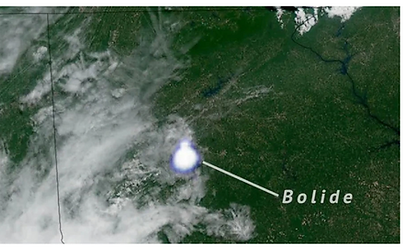
GOES-19 satellite image - NOAA
A local Atlanta meteorite hunter, Steven Dixey, was at the predicted drop zone rapidly. He found a fresh meteorite at 4:50pm and another at 6:45pm that afternoon. The fireball had dropped them in the region of McDonough and Blacksville, Georgia. These finds were very fortunate as a rain storm appeared soon afterwards, and started wetting the meteorites. Luckily his pre-rain sample was sent for analysis to Lawrence Garvie at Arizona State University.
Photo Credit Steven Dixey - first pieces showing flow lines
Within hours more meteorite hunters converged on the predicted strewnfield. I immediately flew to Atlanta and met up with team members Anton Clemens and Matt Stream. We discussed search strategies while we awaited delayed luggage. We did not know what we would find but we had a good idea where to look, based on the radar and weather data. By Saturday morning June 28 I had found my first meteorite half buried in wet clay soil. It was a beautiful 45 g fully crusted intact stone. Soon after the other team members started finding meteorites. By the end of our first day hunting, we had 11 meteorites including a 56 gram specimen for Anton.

Anton, Matt, Dave
Dave's first witnessed fall find on June 28 - 45 gms

Over the next week, we searched residential streets, fields, roadways and parking lots. We met multiple other avid meteorite hunters on the quest, battling enthusiastic mosquitoes, ticks and spiders in the trees and blazing sun, humidity, hail and lightning storms. Some of the hunters we encountered included “Fireball” Steve Arnold, Roberto Vargas and Norman Lebron, Preston Allen and son Jerron (who found his very first meteorite), Cameron and Jodi Smith, Carl Dietrich and his dog Piper, Logan Wesel, Mark and Eric Lyon and of course Michelle and Steven Dixey.

Norm and Roberto

Road smasher pieces found by Carl Deitrich on June 27 2025
On Monday June 30th and Tuesday July 1st our team wandered around a “drop zone” subdivision and talked to the local inhabitants. After instructing several locals on the features of these fresh meteorites, several found stones in their front or backyards. Most of the people we met were welcoming, and fascinated that their community was in the epicenter of this amazing fireball.

A Middle School science teacher was thrilled when Anton located a broken meteorite on her front walk. She planned to show her class the excellent sample demonstrating the crust and interior of the space rock.
One man went out in his backyard and saw that his shed door had been hit. He found a large rock near the shed. It turned out to be 173gm space rock. Several people described hearing the detonation explosions, as well as whizzing or whirring sounds like a series of drones. One man described a tree being hit and shaking in his backyard. This stone is the current main mass. Apparently, at the local jail, windows and doors shook suggesting a shock wave.
I was fortunate to find 17 meteorites, including one beside a vehicle, two small ones on a back patio, another 2 on driveways, several buried in muddy clay, one lying on some pine needles and one lying on leaves. We encountered armadillos, tortoises, a cottonmouth snake, deer, and of course many dogs. Matt was fortunate to see the owner of the current 406gm main mass and take pictures of this.
On the Fourth of July, I partnered with Steve Arnold and videoed him pulling a 16.8gm meteorite out of a swimming pool !!
The tree shaking 406 gram main mass - photo by Matt Stream
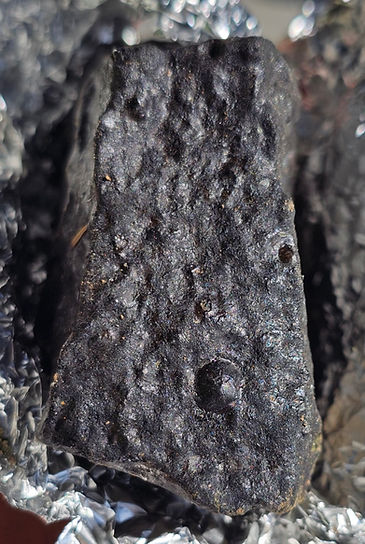

A meteorite fell through a man's roof and ceiling. I spoke with the man, who said he called the police and subsequently staff from Homeland Security came and took the meteorite, possibly thinking it was a projectile. Here's the roof patch.
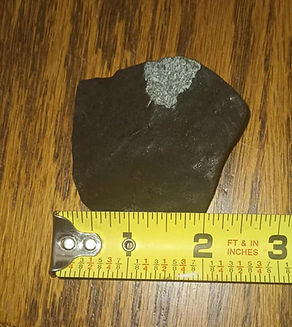
The shed smasher
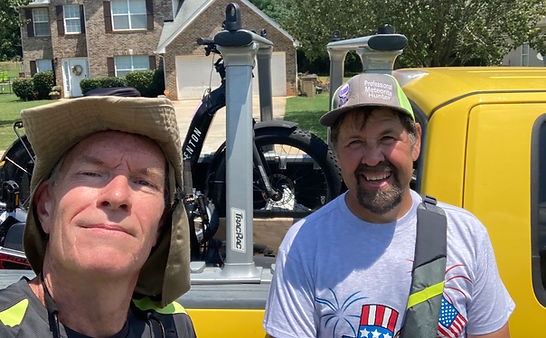
Dave and Steve

16.8 gram meteorite moments after recovering it from the bottom of a swimming pool
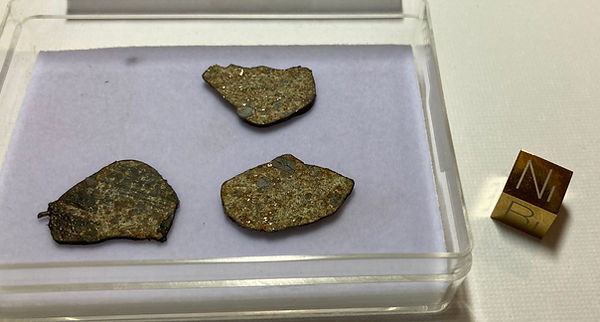
Slices of the stone showing interior discoloration after 8 days in a backyard swimming pool !
All in all, a greatly successful and fun witnessed fireball meteorite hunt ! This meteorite is now officially called McDonough !
Other Recent Falls
"Black Silver Mine"


In April 2024, a fireball was observed visually, on video and on doppler / radar travelling just west of Phoenix, Arizona, with a predicted fall site in an area known as Clanton Well. A few days later, hunters searched the area in the increasing Arizona heat, without success.
Success, however, came in February 2025, as several hunters began to find pieces of this rare CK carbonaceous chondrite. Luisa Stream found the 106gm main mass from this fall, pictured here. It has been named Black Silver Mine.
Thanks to Luisa Stream and Matt Stream for these photgraphs.

Amo
Indiana, USA
A bright fireball was observed over Indiana, USA in December 2024.
Weather radar demonstrated signatures of falling material. Within a few days, meteorite hunters were finding multiple meteorites on hard surfaces as well as embedded in softer ground.
This largest mass of 53 kg was found by Robert Ward and was on display in Tucson Feb 2025.
Holding one of the Amo masses.
Photo's used with kind permission of Robert Ward / Robert Ward Meteorites.


"Stardust Mine"
In 2024, multiple meteorites with fresh black fusion crust were found in Southwestern USA. Incredibly, the meteorite is reported to be a Martian gabbroic shergottite. Meteorite specimens were on display in Tucson Feb 2025. Stardust Mine is the name of this find.
Photos by Dave Kenny taken Feb 4 2025 and used with kind permission of Robert Ward / Robert Ward Meteorites.

Ribbeck (Asteroid BX1)
Germany, Jan 2024. Aubrite.
On Jan 20 2024, an approaching 1 metre sized asteroid named 2024 BX1 was detected, again by Dr. K. Sárneczky. A bright fireball was seen at the predicted time and location northwest of Berlin, Germany on Jan 21, and was widely witnessed and captured on multiple video cameras. It did not take long before meteorite hunters found pieces of this fireball on the ground. It turned out to be an aubrite (a type named after the 1836 Aubres meteorite), a rare magnesium-rich enstatite achondrite.
Unlike most fresh meteorites, it has a thin white to grey crust, with some areas transparent, and a white interior. It is quite friable. Parts of the meteorite fluoresce under UV light.

Thanks to IMCA president and meteorite hunter Roberto Vargas who traveled to Germany and procured this piece. Photo taken Jan 31 2024, 10 days after it landed on Earth !
La Posa Plain - Quartzsite Fireball 2023
Arizona, Dec 2023.
A bright fireball was seen heading southwest over an area north of Quartzsite, Arizona on Dec 28 2023. The event was caught on multiple cameras. With the use of NEXRAD doppler radar data and taking into account local wind conditions, a strewnfield was predicted. On Jan 1 2024, several hunters found fresh pieces. A total of 564.5gms has been found as of May 2024.
Initially referred to as Quartzsite (2023), the official name of this meteorite is now La Posa Plain.

This 70 gram piece with fresh flow-lines was on display at the 2024 Tucson show. Photo taken Jan 31 2024 and used with kind permission of Mark Lyon. (Mark Lyon Meteorites).
Saint-Pierre-le-Viger (Asteroid 2023 CX1)
Normandy, France Feb 13 2023. Chondrite.
This fascinating story began when Asteroid 2023 CX1 was detected as a faint object while still in space by Hungarian astronomer K. Sárneczky on February 12, 2023. At the time it was estimated to be 1 meter in size and heading towards Earth. It was tracked in space for several hours by multiple observatories, fading upon entering the Earth’s shadow. It was then seen as a fireball, first “green like a bright emerald, then orange”, traveling eastward at 14.5km/sec over the English Channel. Shock wave sounds were heard. Scientists accurately predicted that fragments from the asteroid would hit the ground in Normandy, France. Shortly afterwards, teams from France, as well as international meteorite hunters converged on the drop zone. Multiple pieces were found. This is only the third asteroid detected prior to impact leading to meteorites being found on the ground.

Photos of the 175g mass by Dave Kenny with kind permission from Bil Bungay. Taken May 17 2023, a few days prior to transfer to the Paris museum.

2023 CX1 is also the most tracked and observed predicted fall and meteorite find in history. The first 94g stone was found on February 15 by an 18 year-old French student. The largest stone (175g main mass) was found in a 6 inch hole by an American professional meteorite hunter. It was then purchased by Bil Bungay, a UK meteorite hunter/ collector, who has generously made a long-term loan to the Paris National Museum of Natural History.